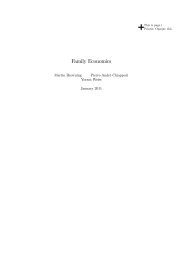Bounded Rationality in Industrial Organization
Bounded Rationality in Industrial Organization
Bounded Rationality in Industrial Organization
You also want an ePaper? Increase the reach of your titles
YUMPU automatically turns print PDFs into web optimized ePapers that Google loves.
Several approaches to model<strong>in</strong>g irrationality can be taken: one can specify rules of thumb,<br />
behavior can be derived as the maximizer of someth<strong>in</strong>g other than utility/profits; or one can<br />
explicitly <strong>in</strong>troduce cognitive bounds. I’ve stressed two advantages of boundedly rational<br />
approaches: boundedly rational behavior seems more realistic <strong>in</strong> some applications; and the<br />
tractability of boundedly rational models can sometimes allow researchers to <strong>in</strong>corporate<br />
additional features <strong>in</strong>to a model. For the next few years at least there is probably also a third<br />
important advantage: after twenty-five years of focus<strong>in</strong>g on rational models, the questions<br />
rational models are best suited to address have been much more thoroughly explored than<br />
questions best addressed <strong>in</strong> boundedly rational models.<br />
I’ve noted that the current literature on boundedly rational <strong>in</strong>dustrial organizaiton<br />
seems to be proceed<strong>in</strong>g along two different branches. One easy way to give advice for the<br />
literature is to suggest that each branch adopt attractive features of the other. In many<br />
papers <strong>in</strong> the IO branch, the particular form of the departures from rationality is motivated<br />
by little more than the author’s <strong>in</strong>tuition that the departure is plausible. More reliance<br />
on empirical and experimental evidence could be a significant improvement. A relative<br />
weakness of the psychology and economics branch is that the papers are less <strong>in</strong>formed by<br />
the exist<strong>in</strong>g IO literature on the topic and don’t live up to exist<strong>in</strong>g IO norms <strong>in</strong> terms of<br />
<strong>in</strong>corporat<strong>in</strong>g consumer heterogeneity, imperfect competition, price discrim<strong>in</strong>ation, etc.<br />
Which of the branches of boundedly rational IO is likely to be most successful <strong>in</strong> the<br />
com<strong>in</strong>g years? Let me say first that I th<strong>in</strong>k <strong>in</strong> the long run the two branches will come<br />
together. Until they do, I th<strong>in</strong>k that hav<strong>in</strong>g both is valuable. My answer to the question of<br />
which will be more successful <strong>in</strong> the next few years depends on the mean<strong>in</strong>g of successful. If<br />
successful means advanc<strong>in</strong>g the IO literature I th<strong>in</strong>k the answer is the first branch. Delv<strong>in</strong>g<br />
<strong>in</strong>to the IO literature and focus<strong>in</strong>g on topics where the exist<strong>in</strong>g explanations are lack<strong>in</strong>g<br />
is the most efficient way to improve a literature. If success is measured by publications or<br />
citations, I th<strong>in</strong>k the answer is the second branch. I noted earlier that an attractive feature<br />
of the psychology and economics literature is that the models developed <strong>in</strong> papers like<br />
Laibson (1997), Fehr and Schmidt (1999), and Eyster and Rab<strong>in</strong> (2005) are mechanically<br />
very much like rationality and can be grafted <strong>in</strong>to just about any model. This creates many<br />
36













